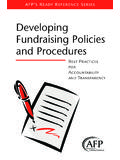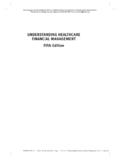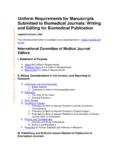Transcription of Developing a Chart of Accounts for a Nonprofit ...
1 Developing a Chart of Accounts for a Nonprofit Organization Barbara Clemenson, CPA, CFRE. 1999, Revised December 2003. The goal of any information system---accounting, donor management, or client management---is to provide useful information to those making decisions. This is especially complicated in accounting, since we must provide internal users with the information they need while still conforming to Generally Accepted Accounting Principles (GAAP) for outside reporting purposes. Our task is further complicated because our internal users have a broad range of interests, varying levels of financial knowledge, and different levels of information needs. The key to fulfilling these requirements is to develop a Chart of Accounts that will permit easy reporting of useful information at a variety of levels in an intuitive manner.
2 In other words, with any information system design you begin at the end and work backwards: What information Does who need At what level of detail In what format? You can then implement that Chart of Accounts into an appropriate accounting software program. The City Mission [ ], a member of the Association of Gospel Rescue Missions [ ], had been using a Chart of Accounts developed by an outside accountant primarily interested in formal, external financial statements. He ordered our expense Accounts in an outwardly logical manner: Food and kitchen supplies, cleaning, and repair expenses Client-related expenses Wages and pension expenses Utilities Insurance (liability, health, auto, building, workers' compensation). Repair and Maintenance expenses Cleaning expenses Staff Development expenses Taxes (FICA).
3 Auto-related expenses Development expenses Office expenses I was hired by a new Executive Director to bring our accounting in-house. He required an internal monthly income statement that made intuitive sense, grouping expenses operationally: Barbara Clemenson 1 Chart of Accounts Employee expenses Client expenses Facility expenses Vehicle expenses Development expenses Organizational expenses Because our Chart of Accounts was not organized that way, each month I had to export the raw information from our accounting system to Excel and manipulate it into the desired format. This resulted in a presentation that made intuitive sense and provided him and the Board with meaningful information. However, because of the time involved, I could not also produce this report for each ministry and division.
4 Meanwhile our development methods had changed and were no longer adequately reflected in the income portion of our Chart of Accounts . Faced with these concerns, and with an expensive accounting software program that was not at that time Windows-based or Y2K certified, I decided to completely redesign our Chart of Accounts and move to a less expensive, easier to use accounting software program. The City Mission at this time has six major ministries and two supporting service divisions, as well as Development and Administration. Each of these areas is a cost-center, responsible only for their expenses. We basically use a two-part account numbering system to track expenses both operationally and by ministry1: Operational Expense Ministry/Division #### ##. This way we can separately report to each ministry/division by running reports based upon the last two numbers of our Accounts , or we can report operations on the organizational level by using the first four numbers of our Accounts .
5 I based the expense portion of our Chart of Accounts on the operational grouping that made sense to our leadership:2. 1. I added a two-character identifier to each account primarily for development and balance sheet reporting purposes. The explanation follows. All development expenses have a single, uniform division code [ They end in "20"]; as do all organizational expenses ["99"]. 2. A detailed Chart of Accounts is found in the Appendix. Barbara Clemenson 2 Chart of Accounts Our People: Employee-Related Expenses 5000-5400. Client Expenses 5500-5900. Our Places: Utilities 6000-6400. Facility Expenses 6500-6900. Our Transportation 7000-7300. Our Donors [Development] 7400-8900. Our Administration: Office Expenses 9100. Organizational Expenses 9200-9900. With this new Chart of Accounts , every month our ministry and division directors receive an expense report in plain English.
6 Not every ministry has every operational expense, but a typical ministry report has this format: The City Mission XXXXX Division Cash Expense Budget Statement For the [Number of months into the Fiscal Year] Ending XXXXXX. Current Year to Year to % of Budget Current Month Date Date Year to Expenses Month Actual Budget Actual Budget Date Employee Expenses Rolled-Up Subtotal of All Employee Expenses Detailed Below Gross Wages Taxes-FICA. Insurance Benefits Workers Compensation Pension Expenses Staff Development Client Expenses Rolled-Up Subtotal of All Client Expenses Detailed Below Food Client Programs Client Use of Camp Utility Expenses Rolled-Up Subtotal of All Utility Expenses Detailed Below Gas Electric Water/Sewer Telephone Facility Expenses Rolled-Up Subtotal of all Facility Expenses Detailed Below Building Insurance Cleaning Supplies Paper Products Small Equipment Repair/Maintenance-Grounds Repair/Maintenance-Buildings Repair/Maintenance-Equipment Vehicle Expenses Rolled-Up Subtotal of all Vehicle Expenses Detailed Below Insurance Gas/Oil Repair/Maintenance Office and Organization Expenses Rolled-Up Subtotal of all Office/Organization Expenses Detailed Below Postage Copies Computer
7 Supplies/Services Liability Insurance Total Expenses Barbara Clemenson 3 Chart of Accounts Division reports summarize and detail (by ministry) relevant expense categories. For example: The City Mission XXXXX Division Cash Expense Budget Statement For the [Number of months into the Fiscal Year] Ending XXXXXX. % of Current Current Year to Year to Budget Month Month Date Date Year to Expenses Actual Budget Actual Budget Date Cleaning Supplies Rolled-Up Subtotal of All Cleaning Expenses Detailed Below Cleaning Supplies-Men's Ministry Cleaning Supplies-Women's Ministry Cleaning Supplies-Camp Ministry Cleaning Supplies-Youth Ministry Cleaning Supplies-Gifts in Kind Ministry Cleaning Supplies-Administration Paper Products Rolled-Up Subtotal of All Paper Product Expenses Detailed Below Paper Products-Men's Ministry Paper Products -Women's Ministry Paper Products -Camp Ministry Paper Products -Youth Ministry Paper Products -Gifts in Kind Ministry Paper Products -Administration Small Equipment Expense Rolled Up Subtotal of All Small Equipment Expenses Detailed Below Small
8 Equipment-Men's Ministry Small Equipment -Women's Ministry Small Equipment -Camp Ministry Small Equipment -Youth Ministry Small Equipment -Gifts in Kind Ministry Small Equipment -Administration Income Accounts and development expense Accounts report the results of our various development strategies. We have mirrored our development income and expense Accounts , identifying them with identical two-character codes, in order to match our income to the expenses incurred in raising those funds, based upon our various development strategies. This permits easy Return on Investment (ROI) analysis. Barbara Clemenson 4 Chart of Accounts Income Accounts Development Expense Accounts Receipt Supplies & Postage Business Reply Postage Regular Cash Newsletter Donor Regular Contributions RC 4000-4300.
9 Donations Radio Cultivation Videos 7400-7900. Other Donor Acquisition Program DA 4400 Donor Acquisition Program DA 8000-8300. Special Appeals SA 4500 Special Appeals SA 8400-8700. United Way Contributions UW 4590. Planned Giving PG 4600 Planned Giving PG 8800. Special Events SE 4700-4770 Special Events SE 8900. Rental Outside Use of Camp 4780. Income The City Mission Use of Camp 4790. Other Other Income ( "rag". 4800. Income money). Interest Income 4810. Dividend Income 4820. Gain/Loss 4830-4840. Gift in Kind Contributions 4900. We use a two-part numbering system for our Regular Contribution income Accounts that tells us who gave us the gift (what donor group: Churches, Individuals, Businesses or Foundations) and where they designated the money (the same code for each ministry we use for expenses): Donor Group Ministry/Division #### ##.
10 Our donor management database is set up to parallel this two-part identification system for ministry designations. When we implement an organizational-wide client management database, that will also use the same two-part structure to identify ministries. Because of these consistencies, I can currently extract, export, combine and analyze donation and expense information by ministry. In the future I will be able to add client service analysis to produce performance-based reports and accurately determine actual per-client expenses. Our Balance Sheet Accounts are more generic, although I have customized them to meet our unique needs. Barbara Clemenson 5 Chart of Accounts In summary, before you dig a foundation you first assess exactly what you need in that building for it to serve your purpose, and then you find the appropriate technical support to help you put your needs into a blueprint.







